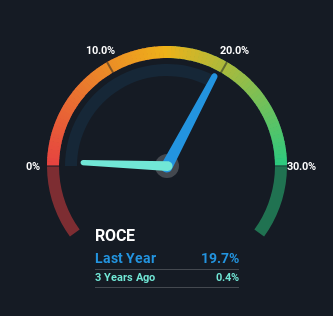- United Kingdom
- /
- Marine and Shipping
- /
- LSE:ICGC
Shareholders Would Enjoy A Repeat Of Irish Continental Group's (LON:ICGC) Recent Growth In Returns
What trends should we look for it we want to identify stocks that can multiply in value over the long term? In a perfect world, we'd like to see a company investing more capital into its business and ideally the returns earned from that capital are also increasing. If you see this, it typically means it's a company with a great business model and plenty of profitable reinvestment opportunities. With that in mind, the ROCE of Irish Continental Group (LON:ICGC) looks great, so lets see what the trend can tell us.
Understanding Return On Capital Employed (ROCE)
If you haven't worked with ROCE before, it measures the 'return' (pre-tax profit) a company generates from capital employed in its business. The formula for this calculation on Irish Continental Group is:
Return on Capital Employed = Earnings Before Interest and Tax (EBIT) ÷ (Total Assets - Current Liabilities)
0.20 = €70m ÷ (€573m - €219m) (Based on the trailing twelve months to December 2023).
Thus, Irish Continental Group has an ROCE of 20%. On its own, that's a very good return and it's on par with the returns earned by companies in a similar industry.
See our latest analysis for Irish Continental Group

In the above chart we have measured Irish Continental Group's prior ROCE against its prior performance, but the future is arguably more important. If you'd like, you can check out the forecasts from the analysts covering Irish Continental Group for free.
The Trend Of ROCE
Irish Continental Group has not disappointed in regards to ROCE growth. The figures show that over the last five years, returns on capital have grown by 96%. The company is now earning €0.2 per dollar of capital employed. In regards to capital employed, Irish Continental Group appears to been achieving more with less, since the business is using 23% less capital to run its operation. If this trend continues, the business might be getting more efficient but it's shrinking in terms of total assets.
For the record though, there was a noticeable increase in the company's current liabilities over the period, so we would attribute some of the ROCE growth to that. Essentially the business now has suppliers or short-term creditors funding about 38% of its operations, which isn't ideal. It's worth keeping an eye on this because as the percentage of current liabilities to total assets increases, some aspects of risk also increase.
What We Can Learn From Irish Continental Group's ROCE
In a nutshell, we're pleased to see that Irish Continental Group has been able to generate higher returns from less capital. Since the total return from the stock has been almost flat over the last five years, there might be an opportunity here if the valuation looks good. That being the case, research into the company's current valuation metrics and future prospects seems fitting.
One more thing to note, we've identified 1 warning sign with Irish Continental Group and understanding it should be part of your investment process.
Irish Continental Group is not the only stock earning high returns. If you'd like to see more, check out our free list of companies earning high returns on equity with solid fundamentals.
New: AI Stock Screener & Alerts
Our new AI Stock Screener scans the market every day to uncover opportunities.
• Dividend Powerhouses (3%+ Yield)
• Undervalued Small Caps with Insider Buying
• High growth Tech and AI Companies
Or build your own from over 50 metrics.
Have feedback on this article? Concerned about the content? Get in touch with us directly. Alternatively, email editorial-team (at) simplywallst.com.
This article by Simply Wall St is general in nature. We provide commentary based on historical data and analyst forecasts only using an unbiased methodology and our articles are not intended to be financial advice. It does not constitute a recommendation to buy or sell any stock, and does not take account of your objectives, or your financial situation. We aim to bring you long-term focused analysis driven by fundamental data. Note that our analysis may not factor in the latest price-sensitive company announcements or qualitative material. Simply Wall St has no position in any stocks mentioned.
About LSE:ICGC
Irish Continental Group
Operates as a maritime transport company in Ireland, the United Kingdom, and Continental Europe.
Proven track record with adequate balance sheet and pays a dividend.
Similar Companies
Market Insights
Community Narratives



